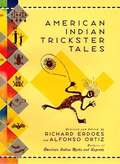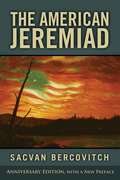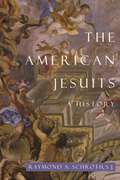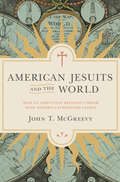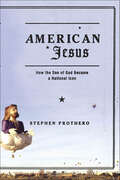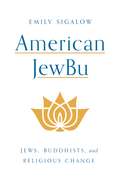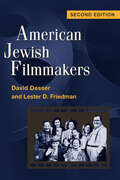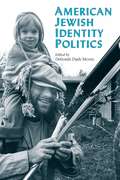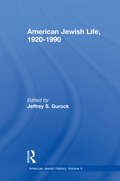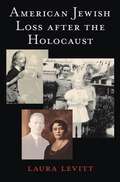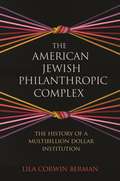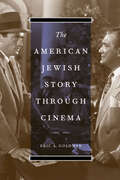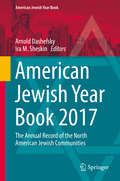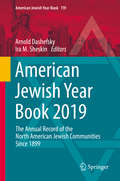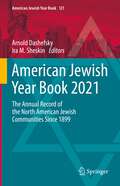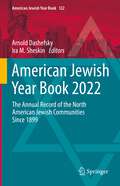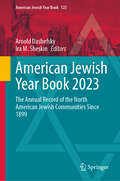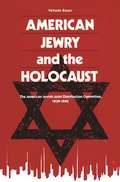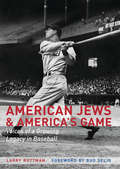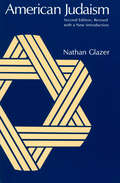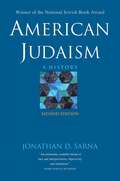- Table View
- List View
American Indian / First Nations Schooling
by Charles L. GlennTracing the history of Native American schooling in North America, this book emphasizes factors in society at large - and sometimes within indigenous communities - which led to Native American children being separate from the white majority. Charles L. Glenn examines the evolving assumptions about race and culture as applied to schooling, the reactions of parents and tribal leadership in the United States and Canada, and the symbolic as well as practical role of indigenous languages and of efforts to maintain them.
American Indian Trickster Tales
by Richard Erdoes Alfonso Ortizit's the Trickster who provides the real spark in the action
The American Jeremiad
by Sacvan BercovitchWhen Sacvan Bercovitch'sThe American Jeremiadfirst appeared in 1978, it was hailed as a landmark study of dissent and cultural formation in America, from the Puritans' writings through the major literary works of the antebellum era. For this long-awaited anniversary edition, Bercovitch has written a deeply thoughtful and challenging new preface that reflects on his classic study of the role of the political sermon, or jeremiad, in America from a contemporary perspective, while assessing developments in the field of American studies and the culture at large.
The American Jesuits: A History
by Raymond A SchrothChoice Outstanding Academic Title for 2008A broad and compelling look at the impact of the largest Catholic order of men on American cultureWith infectious energy and a genuine gift for storytelling, Raymond A. Schroth recounts the history of Jesuits in the United States. The American Jesuits isn’t simply a book for Catholics; it’s for anyone who loves a well-told historical tale. For more than 450 years, Jesuit priests have traveled the globe out of a religious commitment to serve others. Their order, the Society of Jesus, is the largest religious order of men in the Catholic Church, with more than 20,000 members around the world and almost 3,000 in the United States. It is one of the more liberal orders in the Church, taking very public stands in the U.S. on behalf of social justice causes such as the promotion of immigrants’ rights and humanitarian aid, including assistance to Africa’s poor, and against American involvement in “unjust wars.” Jesuits have played an important part in Americanizing the Catholic Church and in preparing Catholic immigrants for inclusion into American society.Starting off with the first Jesuit to reach the New World—he was promptly murdered on the Florida coast—Schroth focuses on the key periods of the Jesuit experience in the Americas, beginning with the era of European explorers, many of whom were accompanied by Jesuits and some of whom were Jesuits themselves. Suppressed around the time of the American Revolution, the Society experienced resurgence in the nineteenth century, arriving in the U.S. along with waves of Catholic immigrants and establishing a network of high schools and universities. In the mid-twentieth century, the Society transformed itself to serve an urbanizing nation.Schroth is not blind to the Society’s shortcomings and not all of his story reflects well on the Jesuits. However, as he reminds readers, Jesuits are not gods and they don’t dwell in mountaintop monasteries. Rather, they are imperfect men who work in a messy world to “find God in all things” and to help their fellow men and women do the same.A quintessential American tale of men willing to take risks — for Indians, blacks, immigrants, and the poor, and to promote a loving picture of God—The American Jesuits offers a broad and compelling look at the impact of this 400-year-old international order on American culture and the culture’s impact on the Jesuits.
American Jesuits and the World: How an Embattled Religious Order Made Modern Catholicism Global
by John T. McgreevyAt the start of the nineteenth century, the Jesuits seemed fated for oblivion. Dissolved as a religious order in 1773 by one pope, they were restored in 1814 by another, but with only six hundred aged members. Yet a century later, the Jesuits numbered seventeen thousand men and were at the vanguard of the Catholic Church's expansion around the world. In the United States especially, foreign-born Jesuits built universities and schools, aided Catholic immigrants, and served as missionaries. This book traces this nineteenth-century resurgence, showing how Jesuits nurtured a Catholic modernity through a disciplined counterculture of parishes, schools, and associations.Drawing on archival materials from three continents, American Jesuits and the World tracks Jesuits who left Europe for America and Jesuits who left the United States for missionary ventures across the Pacific. Each chapter tells the story of a revealing or controversial event, including the tarring and feathering of an exiled Swiss Jesuit in Maine, the efforts of French Jesuits in Louisiana to obtain Vatican approval of a miraculous healing, and the educational efforts of American Jesuits in Manila. These stories place the Jesuits at the center of the worldwide clash between Catholics and liberal nationalists, and reveal how the Jesuits not only revived their own order but made modern Catholicism more global.The result is a major contribution to modern global history and an invaluable examination of the meaning of religious liberty in a pluralistic age.
American Jesus: How the Son of God Became a National Icon
by Stephen ProtheroThe many guises in which Jesus has been represented.
American Jesus: How the Son of God Became a National Icon
by Stephen ProtheroA Deep Dive into America's Complex Relationship with JesusThere's no denying America's rich religious background–belief is woven into daily life. But as Stephen Prothero argues in American Jesus, many of the most interesting appraisals of Jesus have emerged outside the churches: in music, film, and popular culture; and among Jews, Muslims, Buddhists, and people of no religion at all.Delve into this compelling chronicle as it explores how Jesus, the carpenter from Nazareth, has been refashioned into distinctly American identities over the centuries. From his enlistment as a beacon of hope for abolitionists to his appropriation as a figurehead for Klansmen, the image of Jesus has been as mercurial as it is influential. In this diverse and conflicted scene, American Jesus stands as a testament to the peculiar fusion of the temporal and divine in contemporary America.Equal parts enlightening and entertaining, American Jesus goes beyond being simply a work of history. It’s an intricate mirror, reflecting the American spirit while questioning the nation's socio-cultural fabric.
American JewBu: Jews, Buddhists, and Religious Change
by Emily SigalowA revealing look at the Jewish American encounter with BuddhismToday, many Jewish Americans are embracing a dual religious identity, practicing Buddhism while also staying connected to their Jewish roots. This book tells the story of Judaism's encounter with Buddhism in the United States, showing how it has given rise to new contemplative forms within American Judaism—and shaped the way Americans understand and practice Buddhism.Taking readers from the nineteenth century to today, Emily Sigalow traces the history of these two traditions in America and explains how they came together. She argues that the distinctive social position of American Jews led them to their unique engagement with Buddhism, and describes how people incorporate aspects of both into their everyday lives. Drawing on a wealth of original in-depth interviews conducted across the nation, Sigalow explores how Jewish American Buddhists experience their dual religious identities. She reveals how Jewish Buddhists confound prevailing expectations of minority religions in America. Rather than simply adapting to the majority religion, Jews and Buddhists have borrowed and integrated elements from each other, and in doing so they have left an enduring mark on the American consciousness.American JewBu highlights the leading role that American Jews have played in the popularization of meditation and mindfulness in the United States, and the profound impact that these two venerable traditions have had on one another.
The American Jewish Experience (2nd Edition)
by Jonathan D. SarnaThe second edition of this textbook constitutes a substantial revision designed to take advantage of recent scholarship in the field. Nine new pieces have been added, requiring me to delete seven excellent chapters from the earlier edition for which room could no longer be found.
American Jewish Filmmakers
by David Desser Lester D. FriedmanWoody Allen, Mel Brooks, Sidney Lumet, and Paul Mazursky, all sons of East European Jews, remain among the most prominent contemporary American film directors. In this revised, updated second edition of American Jewish Filmmakers, David Desser and Lester D. Friedman demonstrate how the Jewish experience gives rise to an intimately linked series of issues in the films of these and other significant Jewish directors. The effects of the Holocaust linger, both in gripping dramatic form (Mazursky's Enemies, a Love Story) and in black comedy (Brooks's The Producers). In his trilogy consisting of Serpico, Prince of the City, and Q&A, Lumet focuses on the failure of society's institutions to deliver social justice. Woody Allen portrays urban life and family relationships (Manhattan and Hannah and Her Sisters), sometimes with a nostalgic twist (Radio Days). This edition concludes with a newly written discussion of the careers of other prominent Jewish filmmakers such as Steven Spielberg, Barry Levinson, Brian Singer, and Darren Aronofsky.
American Jewish Identity Politics
by Deborah Dash MooreWritten by scholars who grew up after World War II and the Holocaust who participated in political struggles in the 1960s and 1970s and who articulated many of the formative concepts of modern Jewish studies, this anthology provides a window into an era of social change. These men and women are among the leading scholars of Jewish history, society and culture. The volume is organized around contested themes in American Jewish life: the Holocaust and World War II, religious pluralism and authenticity, intermarriage and Jewish continuity. Thus, it offers one of the few opportunities for students to learn about these debates from participant scholars.
American Jewish Life, 1920-1990: American Jewish History (American Jewish History #4)
by Jeffrey S. GurockThis volume contains articles on Jewish life from 1920 to the present. Its entries include studies of the economy and migration in postwar America, the impact of Holocaust survivors on American Society and the reaction to gender stereotypes within American Culture.
American Jewish Loss after the Holocaust
by Laura LevittMany of us belong to communities that have been scarred by terrible calamities. And many of us come from families that have suffered grievous losses. How we reflect on these legacies of loss and the ways they inform each other are the questions Laura Levitt takes up in this provocative and passionate book.An American Jew whose family was not directly affected by the Holocaust, Levitt grapples with the challenges of contending with ordinary Jewish loss. She suggests that although the memory of the Holocaust may seem to overshadow all other kinds of loss for American Jews, it can also open up possibilities for engaging these more personal and everyday legacies.Weaving in discussions of her own family stories and writing in a manner that is both deeply personal and erudite, Levitt shows what happens when public and private losses are seen next to each other, and what happens when difficult works of art or commemoration, such as museum exhibits or films, are seen alongside ordinary family stories about more intimate losses. In so doing she illuminates how through these “ordinary stories” we may create an alternative model for confronting Holocaust memory in Jewish culture.
The American Jewish Philanthropic Complex: The History of a Multibillion-Dollar Institution
by Lila Corwin BermanThe first comprehensive history of American Jewish philanthropy and its influence on democracy and capitalismFor years, American Jewish philanthropy has been celebrated as the proudest product of Jewish endeavors in the United States, its virtues extending from the local to the global, the Jewish to the non-Jewish, and modest donations to vast endowments. Yet, as Lila Corwin Berman illuminates in The American Jewish Philanthropic Complex, the history of American Jewish philanthropy reveals the far more complicated reality of changing and uneasy relationships among philanthropy, democracy, and capitalism.With a fresh eye and lucid prose, and relying on previously untapped sources, Berman shows that from its nineteenth-century roots to its apex in the late twentieth century, the American Jewish philanthropic complex tied Jewish institutions to the American state. The government’s regulatory efforts—most importantly, tax policies—situated philanthropy at the core of its experiments to maintain the public good without trammeling on the private freedoms of individuals. Jewish philanthropic institutions and leaders gained financial strength, political influence, and state protections within this framework. However, over time, the vast inequalities in resource distribution that marked American state policy became inseparable from philanthropic practice. By the turn of the millennium, Jewish philanthropic institutions reflected the state’s growing investment in capitalism against democratic interests. But well before that, Jewish philanthropy had already entered into a tight relationship with the governing forces of American life, reinforcing and even transforming the nation’s laws and policies.The American Jewish Philanthropic Complex uncovers how capitalism and private interests came to command authority over the public good, in Jewish life and beyond.
The American Jewish Story through Cinema (Jewish Life, History, and Culture)
by Eric A. GoldmanLike the haggadah, the traditional “telling” of the story of the Israelites’ exodus from Egypt that is read at the Passover seder, cinema offers a valuable text from which to gain an understanding of the social, political, and cultural realities of Jews in America. In an industry strongly influenced by Jewish filmmakers who made and continue to make the decisions as to which films are produced, the complex and evolving nature of the American Jewish condition has had considerable impact on American cinema and, in particular, on how Jews are reflected on the screen. This groundbreaking study analyzes select mainstream films from the beginning of the sound era to today to provide an understanding of the American Jewish experience over the last century. In the first half of the twentieth century, Hollywood’s movie moguls, most of whom were Jewish, shied away from asserting a Jewish image on the screen for fear that they might be too closely identified with that representation. Over the next two decades, Jewish moviemakers became more comfortable with the concept of a Jewish hero and with an overpowered, yet heroic, Israel. In time, the Holocaust assumed center stage as the single event with the greatest effect on American Jewish identity. Recently, as American Jewish screenwriters, directors, and producers have become increasingly comfortable with their heritage, we are seeing an unprecedented number of movies that spotlight Jewish protagonists, experiences, and challenges.
American Jewish Year Book 2017: The Annual Record of the North American Jewish Communities (American Jewish Year Book #117)
by Ira M. Sheskin Arnold DashefskyThe American Jewish Year Book, now in its 117th year, is the annual record of the North American Jewish communities and provides insight into their major trends. The first chapter of Part I is an examination of how American Jews fit into the US religious landscape, based on Pew Research Center studies. The second chapter examines intermarriage. Chapters on "The Domestic Arena" and "The International Arena" analyze the year's events as they affect American Jewish communal and political affairs. Three chapters analyze the demography and geography of the US, Canada, and world Jewish populations. Part II provides lists of Jewish institutions, including federations, community centers, social service agencies, national organizations, synagogues, Hillels, day schools, camps, museums, and Israeli consulates. The final chapters present national and local Jewish periodicals and broadcast media; academic resources, including Jewish Studies programs, books, journals, articles, websites, and research libraries; and lists of major events in the past year, Jewish honorees, and obituaries.
American Jewish Year Book 2019: The Annual Record of the North American Jewish Communities Since 1899 (American Jewish Year Book #119)
by Arnold Dashefsky Ira M. SheskinPart I of each volume will feature 5-7 major review chapters, including 2-3 long chapters reviewing topics of major concern to the American Jewish community written by top experts on each topic, review chapters on "National Affairs" and "Jewish Communal Affairs" and articles on the Jewish population of the United States and the World Jewish Population. Future major review chapters will include such topics as Jewish Education in America, American Jewish Philanthropy, Israel/Diaspora Relations, American Jewish Demography, American Jewish History, LGBT Issues in American Jewry, American Jews and National Elections, Orthodox Judaism in the US, Conservative Judaism in the US, Reform Judaism in the US, Jewish Involvement in the Labor Movement, Perspectives in American Jewish Sociology, Recent Trends in American Judaism, Impact of Feminism on American Jewish Life, American Jewish Museums, Anti-Semitism in America, and Inter-Religious Dialogue in America. Part II-V of each volume will continue the tradition of listing Jewish Federations, national Jewish organizations, Jewish periodicals, and obituaries. But to this list are added lists of Jewish Community Centers, Jewish Camps, Jewish Museums, Holocaust Museums, and Jewish honorees (both those honored through awards by Jewish organizations and by receiving honors, such as Presidential Medals of Freedom and Academy Awards, from the secular world). We expand the Year Book tradition of bringing academic research to the Jewish communal world by adding lists of academic journals, articles in academic journals on Jewish topics, Jewish websites, and books on American and Canadian Jews. Finally, we add a list of major events in the North American Jewish Community.
American Jewish Year Book 2020: The Annual Record of the North American Jewish Communities Since 1899 (American Jewish Year Book #120)
by Arnold Dashefsky Ira M. SheskinThe American Jewish Year Book, which spans three different centuries, is the annual record of the North American Jewish communities and provides insight into their major trends. Part I of the current volume contains the lead article: Chapter 1, “Pastrami, Verklempt, and Tshoot-spa: Non-Jews’ Use of Jewish Language in the US” by Sarah Bunin Benor. Following this chapter are three on domestic and international events, which analyze the year’s events as they affect American Jewish communal and political affairs. Three chapters analyze the demography and geography of the US, Canada, and world Jewish populations. Part II provides lists of Jewish institutions, including federations, community centers, social service agencies, national organizations, synagogues, Hillels, camps, museums, and Israeli consulates. The final chapters present national and local Jewish periodicals and broadcast media; academic resources, including Jewish Studies programs, books, journals, articles, websites, and research libraries; and lists of major events in the past year, Jewish honorees, and obituaries. While written mostly by academics, this volume conveys an accessible style, making it of interest to public officials, professional and lay leaders in the Jewish community, as well as the general public and academic researchers. The American Jewish Year Book has been a key resource for social scientists exploring comparative and historical data on Jewish population patterns. No less important, the Year Book serves organization leaders and policy makers as the source for valuable data on Jewish communities and as a basis for planning. Serious evidence-based articles regularly appear in the Year Book that focus on analyses and reviews of critical issues facing American Jews and their communities which are indispensable for scholars and community leaders.Calvin Goldscheider, Professor Emeritus of Sociology and Ungerleider Professor Emeritus of Judaic Studies, Brown University They have done it again. The American Jewish Year Book has produced yet another edition to add to its distinguished tradition of providing facts, figures and analyses of contemporary life in North America. Its well-researched and easily accessible essays offer the most up to date scrutiny of topics and challenges of importance to American Jewish life; to the American scene of which it is a part and to world Jewry. Whether one is an academic or professional member of the Jewish community (or just an interested reader of all things Jewish), there is not another more impressive and informative reading than the American Jewish Year Book. Debra Renee Kaufman, Professor Emerita and Matthews Distinguished University Professor, Northeastern University
American Jewish Year Book 2021: The Annual Record of the North American Jewish Communities Since 1899 (American Jewish Year Book #121)
by Arnold Dashefsky Ira M. SheskinAcross three centuries, AJYB has provided insight into major trends. Part I of the current volume contains two chapters on Jewish Americans in 2020 by the Pew Research Center, including reactions from 16 prominent social scientists. Subsequent chapters analyze the development of Holocaust consciousness in America, recent domestic and international events as they affect the American Jewish community, and the demography and geography of the US, Canada, and world Jewish populations. Part II provides lists of Jewish institutions, including federations, community centers, social service agencies, national organizations, camps, museums, and Israeli consulates. The final chapters present lists of Jewish periodicals and broadcast media, Jewish Studies programs, books, journals, articles, websites, research libraries, and academic conferences and lists of major events in the past year, Jewish honorees, and obituaries. This volume employs an accessible style, making it of interest to public officials, Jewish professional and lay leaders, as well as the general public and academic researchers.For more than 120 years the American Jewish Year Book has served as an indispensable resource for scholars, clergy, and lay leaders, providing crucial, detailed insights into demographic shifts and sociological trends in the North American Jewish community. The latest edition continues to fulfill these important needs with essential articles on the landmark Pew Report and the impact of the Holocaust in the American Jewish community and American in general. This is a must-have volume for any serious student of the contemporary Jewish world.Jeffrey Shoulson, Senior Vice Provost for Academic Affairs, Professor of Literatures, Cultures, and Languages, and English, Director Emeritus Center for Judaic Studies and Contemporary Jewish Life, University of ConnecticutThe American Jewish Year Book is a critical snapshot of Jews and Jewish Studies in the United States in a particular year, and a valuable resource for scholars studying the changes in Jewish communities and Jewish Studies in the United States (and beyond!) over time. The AJYB highlights major publications and data that are consistently used in research, and its scholarly essays contextualize the information in an easily readable context. The lists of important institutions and organizations are invaluable for someone interested in the broader Jewish experience (or, at the most practical, a Jewish organization in their neighborhood!).Michelle Margolis Chesner, Norman E. Alexander Librarian for Jewish Studies, Columbia University
American Jewish Year Book 2022: The Annual Record of the North American Jewish Communities Since 1899 (American Jewish Year Book #122)
by Arnold Dashefsky Ira M. SheskinAcross three different centuries, the American Jewish Year Book has provided insight into major trends among Jews primarily in North America. Part I of the current volume contains two chapters: One is a critical assessment of the major American Jewish Population Surveys over the past fifty years (1970-2020). The second chapter is an assessment of the media coverage of Israel in the American Press. Subsequent chapters address recent domestic and international events as they affect the American Jewish community, and the demography and geography of the US, Canada, and World Jewish populations. Part II provides lists of Jewish institutions, including federations, community centers, social service agencies, national organizations, camps, museums, and Israeli consulates. The final chapters present lists of Jewish periodicals and broadcast media, Jewish Studies programs, books, journals, articles, websites, research libraries, and academic conferences as well as lists of major events in the past year, Jewish honorees, and obituaries. This volume employs an accessible style, making it of interest to public officials, Jewish professional and lay leaders, as well as the general public and academic researchers.The American Jewish Year Book is a tremendously useful resource for scholars, Jewish community professionals, pundits, clergy, and policy makers. For over a century, it has offered comprehensive insight into North American Jewish demography, sociology, and culture. It remains a vital source for comprehending the complexities of American and Canadian Jewish life.Robin Judd, Associate Professor of History and Director of the Hoffman Program for Leaders and Leadership in History, The Ohio State UniversityThe American Jewish Year Book is the first draft of history, documenting the trends and topics of interest for such an organized community. Looking through the 100+ volumes, we can track how discussions have changed over time, which concerns have returned, and how we arrived at the current point in time. It is a valuable tool for anyone interested in trends in American Jewish life.David Manchester, Director of the Berman Jewish DataBank and Director of Community Data and Research Development at The Jewish Federations of North America
American Jewish Year Book 2023: The Annual Record of the North American Jewish Communities Since 1899 (American Jewish Year Book #123)
by Arnold Dashefsky Ira M. SheskinAcross three centuries, AJYB has provided insight into major trends. Part I of the current volume contains eight chapters: The first lead chapter includes an Audit of Antisemitic Incidents in 2023 produced by the ADL, and the second chapter examines Denominational Identity and Jewish Engagement. Subsequent chapters analyze recent domestic and international events as they affect the American Jewish community, major events in the past year, and the demography and geography of the US, Canada, and World Jewish populations. Part II contains nine chapters: lists of local Jewish organizations; Jewish museums, and Holocaust museums and monuments; overnight camps; national Jewish organizations; Jewish press; Jewish academic programs; Jewish academic resources; Jewish honorees; and Jewish obituaries. This volume employs an accessible style, making it of interest to public officials, Jewish professional and lay leaders, as well as the general public and academic researchers. For more than a century, the American Jewish Year Book has served as an indispensable compendium of Jewish demographic trends, research and data. It is considered a must-read for data scientists, demographers, community leaders or anyone interested in the trends that make up the lifeblood of the Jewish experience in America. We are proud of our contributions to this essential resource. Jonathan A. Greenblatt, CEO and National Director of ADL (the Anti-Defamation League) The American Jewish Year Book is a unique resource of tremendous value to anyone interested in global Jewish life. It is critical for people today, and it will be for those who come after us. Its lists capture not only critical information about key aspects of Jewish communal life, but provide the opportunity for reflection, comparison, and analysis with other religious and ethnic communities. Riv-Ellen Prell, Professor Emerita, American Studies and the Center for Jewish Studies, University of Minnesota
American Jewry and the Holocaust: The American Jewish Joint Distribution Committee, 1939-1945
by Yehuda BauerIn this volume Yehudi Bauer describes the efforts made to aid European victims of World War II by the New York-based American Jewish Joint Distribution Committee, American Jewry's chief representative abroad. Drawing on the mass of unpublished material in the JDC archives and other repositories, as well as on his thorough knowledge of recent and continuing research into the Holocaust, he focuses alternately on the personalities and institutional decisions in New York and their effects on the JDC workers and their rescue efforts in Europe. He balances personal stories with a country-by-country account of the fate of Jews through ought the war years: the grim statistics of millions deported and killed are set in the context of the hopes and frustrations of the heroic individuals and small groups who actively worked to prevent the Nazis' Final Solution. This study is essential reading for anyone who seeks to understand the American Jewish response to European events from 1939 to 1945. Bauer confronts the tremendous moral and historical questions arising from JDC's activities. How great was the danger? Who should be saved first? Was it justified to use illegal or extralegal means? What country would accept Jewish refugees? His analysis also raises an issue which perhaps can never be answered: could American Jews have done more if they had grasped the reality of the Holocaust?
American Jews and America's Game: Voices of a Growing Legacy in Baseball
by Larry Ruttman Dr Martin Abramowitz Allan H SeligMost fans don’t know how far the Jewish presence in baseball extends beyond a few famous players such as Greenberg, Rosen, Koufax, Holtzman, Green, Ausmus, Youkilis, Braun, and Kinsler. In fact, that presence extends to the baseball commissioner Bud Selig, labor leaders Marvin Miller and Don Fehr, owners Jerry Reinsdorf and Stuart Sternberg, officials Theo Epstein and Mark Shapiro, sportswriters Murray Chass, Ross Newhan, Ira Berkow, and Roger Kahn, and even famous Jewish baseball fans like Alan Dershowitz and Barney Frank. The life stories of these and many others, on and off the field, have been compiled from nearly fifty in-depth interviews and arranged by decade in this edifying and entertaining work of oral and cultural history. In American Jews and America’s Game each person talks about growing up Jewish and dealing with Jewish identity, assimilation, intermarriage, future viability, religious observance, anti-Semitism, and Israel. Each tells about being in the midst of the colorful pantheon of players who, over the past seventy-five years or more, have made baseball what it is. Their stories tell, as no previous book has, the history of the larger-than-life role of Jews in America’s pastime.
American Judaism (The Chicago History of American Civilization)
by Nathan GlazerFirst published in 1957, Nathan Glazer's classic, historical study of Judaism in America has been described by the New York Times Book Review as "a remarkable story . . . told briefly and clearly by an objective historical mind, yet with a fine combination of sociological insight and religious sensitivity." Glazer's new introduction describes the drift away from the popular equation of American Judaism with liberalism during the last two decades and considers the threat of divisiveness within American Judaism. Glazer also discusses tensions between American Judaism and Israel as a result of a revivified Orthodoxy and the disillusionment with liberalism. "American Judaism has been arguably the best known and most used introduction to the study of the Jewish religion in the United States. . . . It is an inordinately clear-sighted work that can be read with much profit to this day."—American Jewish History (1987)
American Judaism: A History, Second Edition
by Jonathan D. SarnaJonathan D. Sarna’s award-winning American Judaism is now available in an updated and revised edition that summarizes recent scholarship and takes into account important historical, cultural, and political developments in American Judaism over the past fifteen years. Praise for the first edition: “Sarna . . . has written the first systematic, comprehensive, and coherent history of Judaism in America; one so well executed, it is likely to set the standard for the next fifty years.”—Jacob Neusner, Jerusalem Post “A masterful overview.”—Jeffrey S. Gurock, American Historical Review “This book is destined to be the new classic of American Jewish history.”—Norman H. Finkelstein, Jewish Book World Winner of the 2004 National Jewish Book Award/Jewish Book of the Year

